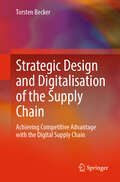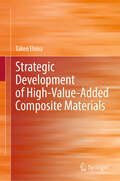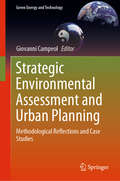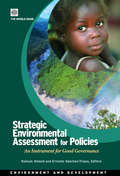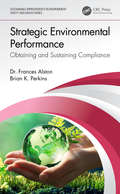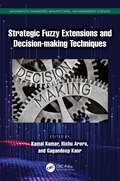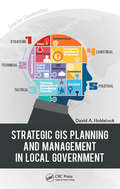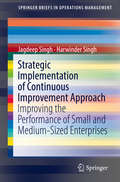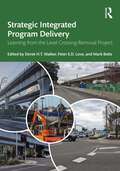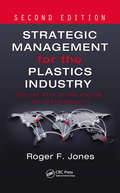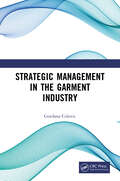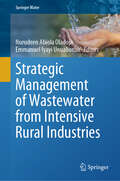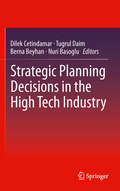- Table View
- List View
Strategic Decision Making for Sustainable Management of Industrial Networks (Greening of Industry Networks Studies #8)
by Jafar RezaeiThis book presents a diverse set of decision-making methodologies to solve some of the most important decisions that most organizations face today. It is an excellent demonstration of some great challenges in our society in the area of sustainability. These great challenges, ranging from sustainability in logistics to the use of renewable energies, needs to be urgently addressed. Sustainability has become one of the most important topics in management and many organizations are taking big steps towards sustainability. Organizations are attempting to use cleaner production technologies and renewable energies sources, to improve health and safety issues within their industries and the products and services they offer. These points involve several important strategic and managerial decisions, highlighted in this book. The book can be used by decision-makers and policy-makers as exemplary guidelines to solve sustainability problems.
Strategic Design and Digitalisation of the Supply Chain: Achieving Competitive Advantage with the Digital Supply Chain
by Torsten BeckerDigital supply chains increase companies' competitiveness. A systematic approach describes the development of strategies to achieve challenging corporate goals with the supply chain and its digitalisation. These include better fulfilling customer requirements, increasing sales, and simultaneously reducing costs. Strategy patterns are presented, and their implementation in companies is described. Entrepreneurs, supply chain, and operations managers receive a practice-oriented guide on how to align their company for the future. The tried-and-tested methods and approaches accelerate and facilitate strategy development, implementation, and support through digital solutions. The focus is on making/buying decisions, finding solutions for skills, digital solutions in production technology (3D printing), and the impact of Industry 4.0 and environmental aspects on the supply chain. Practical examples will show how new solution concepts support the design of future-oriented supply chains. The trigger points that could jeopardise a successful supply chain will also be presented, as well as the design for time and cost optimisation in the overall chain. How must a company fundamentally question the historically grown supply chain? What is essential in supply chain optimisation? The strategies presented define the processes, architectures, the use of digital technologies and the deployment of resources - considering the overarching corporate strategy, which calls for shorter delivery times and lower costs to remain competitive.
Strategic Development of High-Value-Added Composite Materials
by Takeo EbinaThis book provides detailed descriptions of material design, from the development of new materials and innovation to the promotion of social acceptance of the products invented. After developing a clay-based film and applying for many related patents, the author engaged in consortium-based development, where different companies simultaneously developed multiple products using the raw material. Throughout this process, the author discovered that developing high-value-added products using new materials requires extensive time and cooperation among various stakeholders. The author coined the term "integrated development" to describe this collaborative approach. This book serves as a guide to the integrated development, presenting numerous examples and generalizations to enable readers to practice integrated development. This book is aimed at material experts, development leaders in companies, research institutes, and support organizations. The most important skills for each stage of development are organized into chapters in sequential order. However, each chapter is independent, allowing readers to focus on the specific chapter they need. The knowledge presented in this book can be utilized to design new materials required across various industries. The English translation of this book from its Japanese original manuscript was done with the help of artificial intelligence. A subsequent human revision of the content was done by the author.
Strategic Disaster Risk Management in Asia
by Huong Ha R. Lalitha S. Fernando Amir MahmoodThis book presents strategies for managing disasters and reducing risks in Asian countries. Given the dynamic changes in the natural environment as well as the patterns of land use and management, the growing populations of the developing nations in Asia, migration patterns, and other social-cultural aspects, the impacts of disasters have increased manifold in Asian countries. Against this backdrop, the book examines disaster management issues such as disaster preparedness, post-disaster reconstruction, peace, development and corruption. The views of different groups of stakeholders are incorporated in the discussion to ensure a comprehensive analysis of and findings on the governance process, as well as best practices in pre- and post-disaster management. The book also includes chapters focusing on aspects often overlooked in the context of disaster management, such as the need to invest in public education to improve public awareness, and approaches to supporting the disabled, the vulnerable and the elderly from disaster risks. In closing, the book presents research on disaster management methods employed by different countries in the Asian region. Acknowledgement: The editors acknowledge the role of the Network of Asia Pacific Schools and Institutes of Public Administration and Governance (NAPSIPAG), which is the largest governance research network in the Asia Pacific region,in bringing out this book. NAPSIPAG has been regularly organizing international meetings of administrators, academia and non-state bodies to provide a forum to the regional scholars to deliberate with the international governance experts. It has also helped the international policy organizations to have a better understanding about the region through a local lens of Asiatic anthropology, ethnography and culture of administration.
Strategic Engineering
by Jacques ArcadeIn the face of increasing complexity, uncertainty and difficulty in the design and implementation of reforms, companies, organizations and institutions must strive to capitalize on the prevailing disarray by acting wisely in overcoming it. Strategic engineering is part of an integrative, tool-based approach, inspired by the life sciences and "creative recursion". This book is structured into three parts, which correspond to the three main phases of the strategic engineering approach: observe and discern; judge and arbitrate; act and intervene. Strategic Engineering has wide appeal, relevant to senior leaders, decisionmakers, managers and practitioners within businesses, government and local authorities. It is also intended for those who wish to develop their capability in anticipatory or transformative management within economic, sociopolitical and strategic contexts.
Strategic Environmental Assessment and Urban Planning: Methodological Reflections and Case Studies (Green Energy and Technology)
by Giovanni CampeolThis volume gathers a selection of research contributions on Strategic Environmental Assessment (SEA), including theoretical and methodological studies and real-world case studies. It sheds new light on the respective steps in the procedure defined in the SEA Directive from theoretical and operational standpoints, intended to enhance the sustainability of plans and programmes adopted by local, regional and national authorities. Improving the legitimacy and transparency of decision-making in the field of environmental management was one of the goals that led the European Commission (EU) to adopt Directive 2001/42/EC on the assessment of environmental programmes’ effects. This book provides a multidisciplinary approach to SEA, and addresses the demand for policies and strategies to strengthen resilience through concrete measures to reduce energy consumption, mitigate pollution, promote social inclusion and create urban identity.
Strategic Environmental Assessment for Policies
by Kulsum Ahmed Ernesto Sanchez-TrianaEnvironmentally and socially sustainable policies are essential for good governance. Strategic Environmental Assessment (SEA) is the key tool for integrating environmental considerations into policies, programs and plans. This book focuses on SEA applied to policies. Through lessons learned from previous use of SEA on policies, it draws lessons on the strengths and weaknesses of current SEA methodology. It then goes on to analyze how policies are formulated and implemented and proposes a new conceptual framework for conducting SEA of policies thatpotentially could be more useful in influencing decision makers to integrate environmental sustainability considerations into policy formulation and implementation.
Strategic Environmental Performance: Obtaining and Sustaining Compliance (Sustainable Improvements in Environment Safety and Health)
by Frances Alston Brian K. PerkinsProtecting our environment has never been more important than it is today in the wake of climate change and the ever-increasing demand on natural resources due to the expanding world population. Environmental protection has been increasingly discussed by concerned citizen groups and politicians in the wake of unexpected environmental disasters that have occurred in recent years. The need to protect drinking water resources, control greenhouse gas emissions, and implement successful waste reduction practices will continue to gain visibility with growing social awareness. Environmental managers and leaders can all benefit from this comprehensive and strategic book which guides them through environmental regulatory requirements and methods that can be used to interpret the regulations, develop programs, and processes to ensure compliance. The book includes a Tool Kit containing resources that can assist a company in assessing and evaluating the strength of their environmental program, systems, and processes so that changes can be made before damages to the environment becomes a reality, and penalties are enforced.
Strategic Fuzzy Extensions and Decision-making Techniques (ISSN)
by Kamal Kumar, Rishu Arora, and Gagandeep KaurThe application of a novel correlation coefficient of linguistic intuitionistic fuzzy sets to medical diagnosis problems provides the topic for Strategic Fuzzy Extensions and Decision-making Techniques. It further explains neutrosophic cubic set-based aggregation operators for library ranking systems, and techniques for order performance by similarity to ideal solution. The text also introduces the new aggregation operators, similarity measures, and distance measures for the fuzzy sets and their extensions.This book: Introduces the new aggregation operators, similarity measures, and distance measures for the fuzzy sets and their extensions. Covers recent studies in the field of fuzzy optimization and decision making such as advanced decision-making algorithms. Highlights the application in the field of image processing and pattern recognition. Presents a technique for order performance by similarity to an ideal solution and VIKOR method for decision-making. Explores the limitations of existing fuzzy decision-making approaches such as the malfunctioning of existing formulations. It is primarily written for senior undergraduate, graduate students, and academic researchers in fields including industrial engineering, manufacturing engineering, production engineering, mechanical engineering, and engineering mathematics.
Strategic GIS Planning and Management in Local Government
by David A. HoldstockThis "how-to" book on planning and managing GIS within local government describes and details the key components of a successful enterprise, sustainable and enduring GIS. It describes the strategic planning process an organization must undertake prior to GIS implementation. The heart of the book is the formula for success that offers a systematic methodology for examining and benchmarking a GIS initiative and the practical and repeatable strategy for success. There are many obstacles to successful GIS implementation, and unfortunately, the local government landscape is riddled with false starts, poorly planned implementations, and glorified mapping systems. This book documents the reason for failure and possible remedies to overcome the challenges to implementation. It discusses pathways to change, ways of improving organizational effectiveness and efficiency, and lays out the organizational approaches, management processes, and leadership actions that are required for GIS to become an indispensable part of an organization. This book is about aiming high, so you can consistently hit your mark by formulating goals and objectives that will tremendously influence the success of a GIS initiative. It details the factors crucial for building an enterprise GIS vision statement that includes governance, data and databases, procedures and workflow, GIS software, GIS training and education, and infrastructure, and how to develop performance measures related to the stated objectives of an organization. The book combines theory with real-world experience to offer guidance on the process of managing GIS implementation. Through key components, this book introduces a new way to think about GIS technology.
Strategic Implementation of Continuous Improvement Approach: Improving the Performance of Small and Medium-Sized Enterprises (SpringerBriefs in Operations Management)
by Harwinder Singh Jagdeep SinghThis book covers the strategic use of continuous improvement (CI) techniques for manufacturing performance improvement. It focuses primarily on strategies that can be adopted by small and middle-sized enterprises in manufacturing in order to meet the global challenges and competition. The book begins with an introduction to CI (or Kaizen), explaining different CI approaches and strategies. Chapter 2 offers a literature review of CI, examining conceptual frameworks, case studies, and surveys. Next, the book deals with the design of the study, detailing the work done in each phase along with the tools, techniques and models. Chapter 4 presents a detailed survey to determine the present status of continuous improvement strategies in the Indian manufacturing industry, to assess the important barriers that effect the implementation of CI strategies, and to also assess the role of key enablers leading to improve the performance of manufacturing operations. Chapter 5 is comprised of detailed case studies to further analyze the application of the discussed CI strategies. The purpose of Chapter 6 is to develop the relationship among the different identified most important barriers in implementing CI approach using interpretive structural modeling (ISM) and classify these barriers depending upon their driving and dependence power. Finally Chapter 7 provides conclusions, addresses potential limitations, and also looks to the future.
Strategic Information Warfare: A New Face of War
by Andrew Riddile Stephanie Williamson Peter A. Wilson Roger C. MolanderFuture U.S. national security strategy is likely to be profoundly affected by the ongoing, rapid evolution of cyberspace--the global information infrastructure--and in particular by the growing dependence of the U.S. military and other national institutions and infrastructures on potentially vulnerable elements of the U.S. national information infrastructure. To examine these effects, the authors conducted a series of exercises employing a methodology known as the Day After ... in which participants are presented with an information warfare crisis scenario and asked to advise the president on possible responses. Participants included senior national security community members and representatives from security-related telecommunications and information-systems industries. The report synthesizes the exercise results and presents the instructions from the exercise materials in their entirety.
Strategic Integrated Program Delivery: Learning from the Level Crossing Removal Project
by Mark Betts Walker, Derek H.T. Love, Peter E.D.This book outlines a cutting-edge form of program delivery which the authors term SIP-Form or Strategic Integrated Program delivery. Using the Melbourne Level Crossing Removal Program (LXRP), consisting of the removal of 85 dangerous level crossings throughout metropolitan Melbourne, including rail station upgrades, signalling and track work, and other associated capital works, as an exemplar, the book sets out four features that the authors argue define the SIP-form concept as follows: The organisation delivers a program of projects, many using an IPD contract variant form such as a Project Alliance Agreement (PAA) in Australia and numerous other countries, or the Integrated Form of Agreement (IFoA) in North America The contract form adopted is used and has been strategically designed to accommodate the project’s risk and uncertainty profile, as is the case with the LXRP Projects within the program are integrated with some being concurrently delivered with coordination across the projects in a coherent and highly purposeful manner. Projects are not included that do not strategically fit the overall program delivery strategy There is a strategy for learning and innovation diffusion across projects, concurrently and sequentially. Lessons to be learned are learned through designed-in governance mechanisms The LXRP is a potentially unique program of projects, and the book takes the reader on a journey through this complex program and after giving the background and relevant context covers topics such as strategy, governance, procurement, collaboration, program alliance, HRM, leadership, digital innovation, continuous improvement, community engagement, and performance measurement. This detailed analysis of such a complex program of projects makes this book essential reading for project managers, engineers, and advanced students of project delivery and management.
Strategic Issues in Air Transport: Legal, Economic and Technical Aspects
by Ruwantissa AbeyratneThere are broadly four strategic issues in aviation: safety; security; environmental protection; and sustainability in air transport. These issues will remain for a long time as key considerations in the safe, regular, efficient and economic development of air transport. Within these four broad categories come numerous subjects that require attention of the aviation industry as well as the States. In six chapters, this book engages in detailed discussions on these subjects as they unravelled in events of recent years. The issue of safety is addressed first, following an introduction of the regulatory regime covering the four issues. Within the area of safety, the book covers such areas as safety management systems, safety and aeromedicine, safety and meteorology, the use of airspace, unmanned aircraft systems and safety oversight audits. In the security area, subjects covered include cyber terrorism, the integrity of travel documents, full body scanners, civil unrest and aviation, the suppression of unlawful acts on board aircraft and the financing of terrorism. The chapter on the environment focuses mainly on climate change - particularly on carbon credits, market based measures, the carbon market and emissions trading schemes and their effect on air transport. Finally, the chapter on sustainability discusses in detail market access along with such issues as slot allocation, open skies, the use of alternative fuels as an economic measure and corporate foresight. The concluding chapter wraps up with a discussion on where air transport is headed.
Strategic Issues in Public-Private Partnerships: An International Perspective
by Mirjam Bult-Spiering Anneloes Blanken Geert DewulfManaging PPP projects is not a routine job, as every PPP project is different and should be managed accordingly. These projects require considerable capability and skills from both public sector and private sector managers involved, Strategic Issues in Public Private Partnerships, Second Edition, delivers the insight and tools necessary to assist those managers. As Public private partnership (PPP) arrangements become an increasingly popular way for national governments to fund and develop public infrastructure and urban areas with private sector contributions, a better understanding of the risks involved is crucial. The second edition of Strategic Issues in Public Private Partnerships : Provides an international overview of the application of concessions - the most common form of PPP [eg PFI (Private Finance Initiative); BO(O)T (Build/Own/Operate/Transfer) or DBFMO (Design/Build/Finance/ Maintain/Operate)]. Focusses on the introduction of concessions and the problems encountered, the solutions found for these problems, and the different approaches to concessions chosen across different countries. Provides a strategic overview for those involved in setting up and managing PPP projects. Illustrates lessons from different national backgrounds and gives managers the insight and tools to manage PPP projects effectively. Essential reading for Contractors & funding organizations involved in PPP projects as well as Researchers in construction management and public administration.
Strategic Management for the Plastics Industry: Dealing with Globalization and Sustainability, Second Edition
by Roger F. JonesAny general management book can give you the basics of quality assurance, strategic planning, logistics, and more. But how do you apply that knowledge to a company that requires not only sound business practices but also sound science to succeed? And how do you deal with the impact of globalized competition, a fluctuating world economy, and growing
Strategic Management in the Garment Industry (Woodhead Publishing India Ser.)
by Gordana ColovicFrom supply chain finesse to market triumph, this book covers the advancements in business strategy and presents a multidisciplinary approach to strategic management in the garment industry. The subject matter of this book discusses – Strategic management Strategic marketing in garment industry Strategic methods Organizational behaviour Print edition not for sale in South Asia (India, Sri Lanka, Nepal, Bangladesh, Pakistan and Bhutan)
Strategic Management of Built Facilities
by Craig Langston Rima Lauge-KristensenThe effective management of facilities can significantly improve business productivity. In this textbook the authors provide an overview of facility economics and outline the way in which businesses and facility managers can get better value from their physical assets.Students on facilities management and property related degrees will find this an invaluable introduction.
Strategic Management of Innovation and Design
by Pascal Le Masson Benoît Weil Armand Hatchuel Pascal Le Masson Benoît WeilThere is now widespread agreement that innovation holds the key to future economic and social prosperity in developed countries. Experts studying contemporary capitalism also agree that the battle against unemployment and relocations can only be won through innovation. But what kind of innovation is required and what is the best way to manage, steer and organize it? Grounded on experiences of innovative firms and based on the most recent design theories, this book argues that instead of relying on traditional R&D and project management techniques, the strategic management of innovation must be based on innovative design activities. It analyses and explains new management principles and techniques that deal with these activities, including innovation fields, lineages, C-K (Concept-Knowledge) diagrams and design spaces. The book is ideal for advanced courses in innovation management in industrial design schools, business schools, engineering schools, as well as managers looking to improve their practice.
Strategic Management of Technological Learning (Technology Management Series)
by Elias CarayannisHow do companies such as BMW, Airbus Industrie, and Bayer leverage technology and learn to thrive where others fail? This book provides a one-stop resource on technology, innovation, and knowledge management. It gives you a tool for gaining short-term, case-specific insight and long-term, industry-wide understanding of the best technology management and learning policies and practices. The Strategic Management of Technological Learning explores a portfolio of case studies on technology-driven-but not exclusively high-tech-companies that have an overall long-term record of success and prosperity.Through in-depth interviews with industry practitioners, the author empirically identifies the presence of Strategic or Active Incrementalism. The following chart shows the studied firms, which operate at high risk and uncertainty, very dynamic, and technologically intensive business environments:
Strategic Management of Wastewater from Intensive Rural Industries (Springer Water)
by Nurudeen Abiola Oladoja Emmanuel Iyayi UnuabonahThis book provides insight into the environmental and ecological impacts of the operations of intensive rural industries and how these undesirable impacts can be effectively managed. In the developing economies, the different human empowerment and poverty alleviation schemes have produced myriads of intensive rural industries that littered States in these economies. These industries are often characterized by their small scale, outmoded technology, obsolete equipment, poor management and large water consumption. Since their operations usually consume large volume of fresh water, high magnitude of untreated wastewater is equally discharged. The huge consumption of freshwater puts a lot of stress on freshwater resource available for human use, and the discharge of contaminated wastewater from these industries disrupts the ecological balance. It has been reported that untreated industrial waste constitutes about two-thirds of the total waste discharge into water bodies, and the largest chunk of this is derived from rural enterprises. Therefore, the environmental cost of rural industrialization is enormous and needs to be examined.The evaluation of the quality characteristics, the socioeconomic impacts and the law guiding the generation and the discharge of the wastewater from specific rural industries are enunciated. The conventional practice and the trends in the effective management of specific wastewater samples are also discussed.
Strategic Planning Decisions in the High Tech Industry
by Berna Beyhan Dilek Cetindamar Tugrul Daim Nuri BasogluThe scale and complexity of research and practices of open innovation mandate a correspondingly sophisticated form of decision making. Strategic Planning Decisions brings together a number of tools that ease the decision process in technology companies, providing both conceptual frameworks and practical applications. Innovative approaches are presented such as an ontology-based model where all the relevant aspects of a potential technology are interrelated to provide a comprehensive and logically connected data pool for decision makers. Divided into two sections, Strategic Planning Decisions describe both strategic approaches using the decision tools, and tactical approaches. Some of these tools are expanded while some others are embedded in a model that will lay the ground for practical application. These include: bibliometric analysis, ontology, roadmapping, lead user, six sigma, and multi-actor & multi-objective decision making methods Recent research and relevant theory are balanced with up-to-date practical applications and hands-on techniques making Strategic Planning Decisions ideal for engineers who wish to keep up-to-date with current ideas in the field of TM. It also provides workable methods for practising managers from all levels who wish to apply a more rigorous approach in their work and consultants concerned with technology assessment and its management.
Strategic Planning Models for Reverse and Closed-Loop Supply Chains
by Kishore K. Pochampally Surendra M. Gupta Satish NukalaThe rapid technological development of new products, coupled with the growing consumer desire for the latest technology, has led to a new environmental problem: products that are discarded prematurely. But behind every problem lies an opportunity. Many of these products can be reprocessed, leading to savings in natural resources, energy, landfill s
Strategic Planning for Urban Transportation: A Dynamic Performance Management Approach (System Dynamics for Performance Management & Governance #3)
by Guido NotoThis book focuses on the adoption of a Dynamic Performance Management (DPM) approach to support the planning and management of urban transportation systems. DPM allows one to embrace a dynamic and systemic perspective and, as a result, to frame the contribution of different stakeholders, in terms of outcome-based performance, at an inter-institutional level. The discussed DPM approach allows one to focus on the causal relationships and feedback processes that characterize urban transportation systems’ governance. Particularly, through the adoption of such an approach, it is possible to identify outcome-based performance measures that help to monitor and drive the governance network toward the creation of public value for the reference communities.Strategic Planning for Urban Transportation: A Dynamic Performance Management Approach begins with an examination of urban transportation, highlighting the main criticalities and future challenges of managing it. Next, the book examines the governance of urban transportation including how to identify and engage stakeholders. Finally, the book introduces the main application of DPM and system dynamics to urban areas, with specific regards to transportation. The framework is outlined, and a case study is provided as a practical example of how to apply the model. This book should be useful to urban transportation decision-makers at both the managerial and political level.
Strategic Planning for the Florida Citrus Industry: Addressing Citrus Greening Disease
by National Research Council of the National AcademiesCitrus greening, a disease that reduces yield, compromises the flavor, color, and size of citrus fruit and eventually kills the citrus tree, is now present in all 34 Floridian citrus-producing counties. Caused by an insect-spread bacterial infection, the disease reduced citrus production in 2008 by several percent and continues to spread, threatening the existence of Florida's $9.3 billion citrus industry. A successful citrus greening response will focus on earlier detection of diseased trees, so that these sources of new infections can be removed more quickly, and on new methods to control the insects that carry the bacteria. In the longerterm, technologies such as genomics could be used to develop new citrus strains that are resistant to both the bacteria and the insect.

